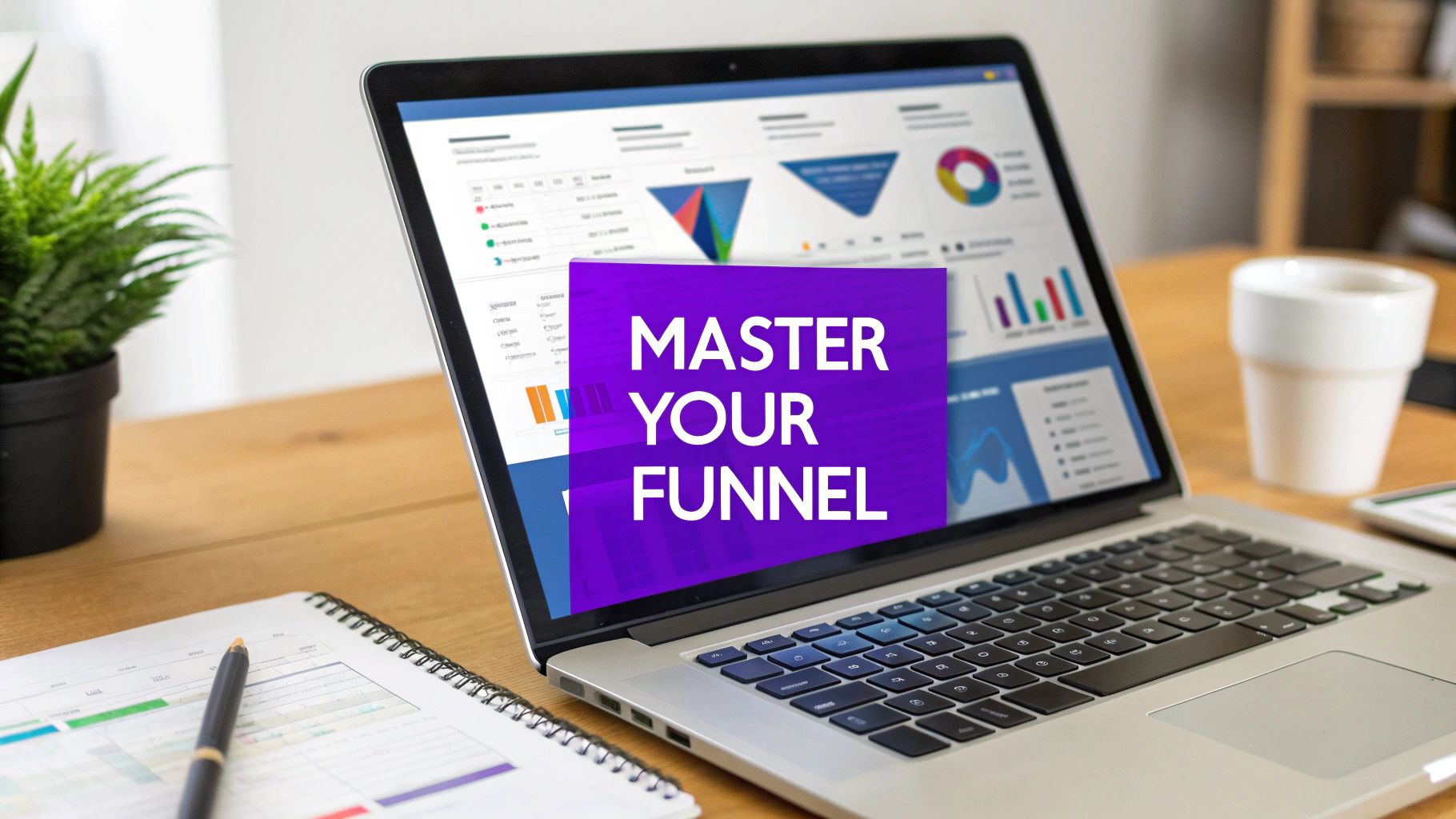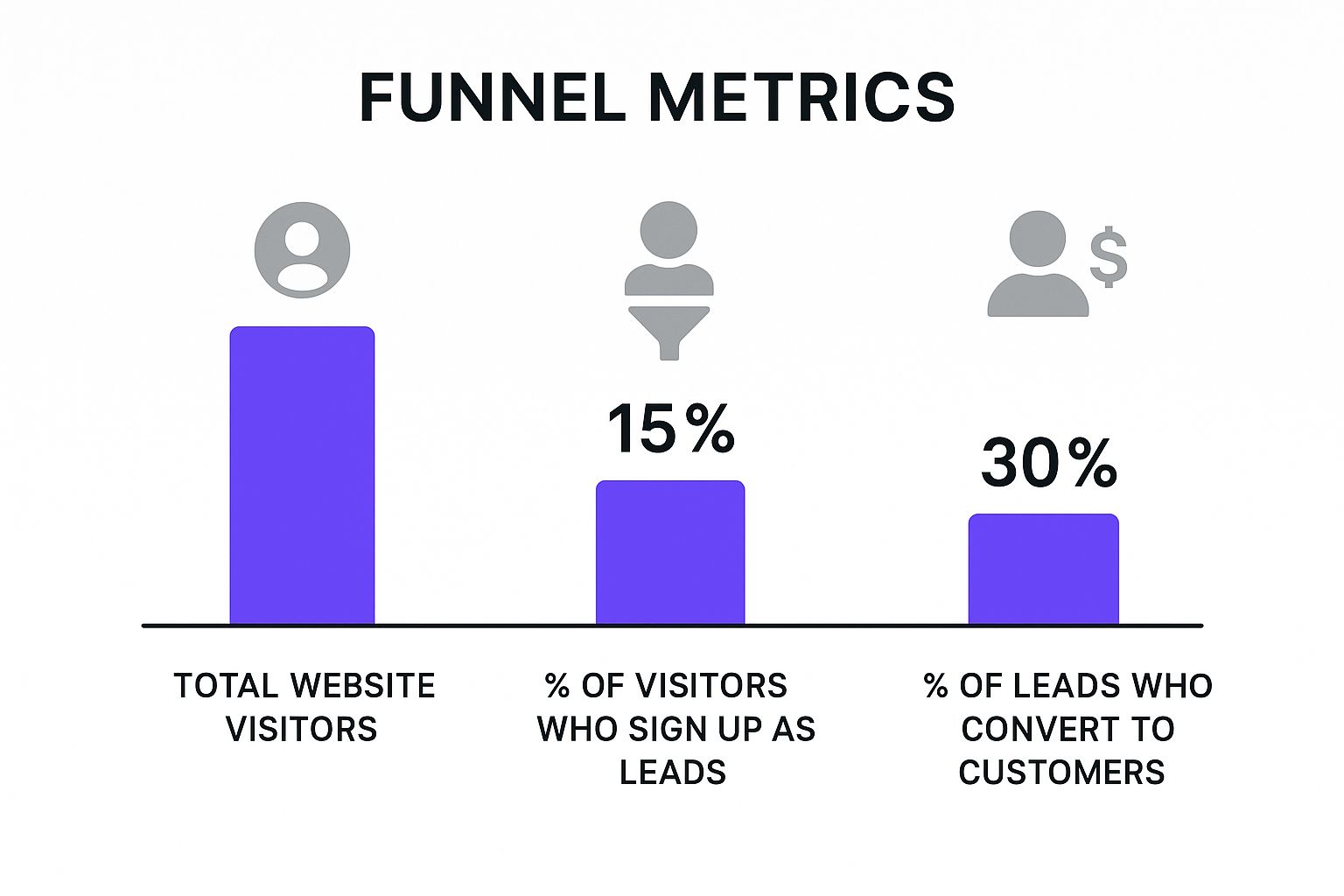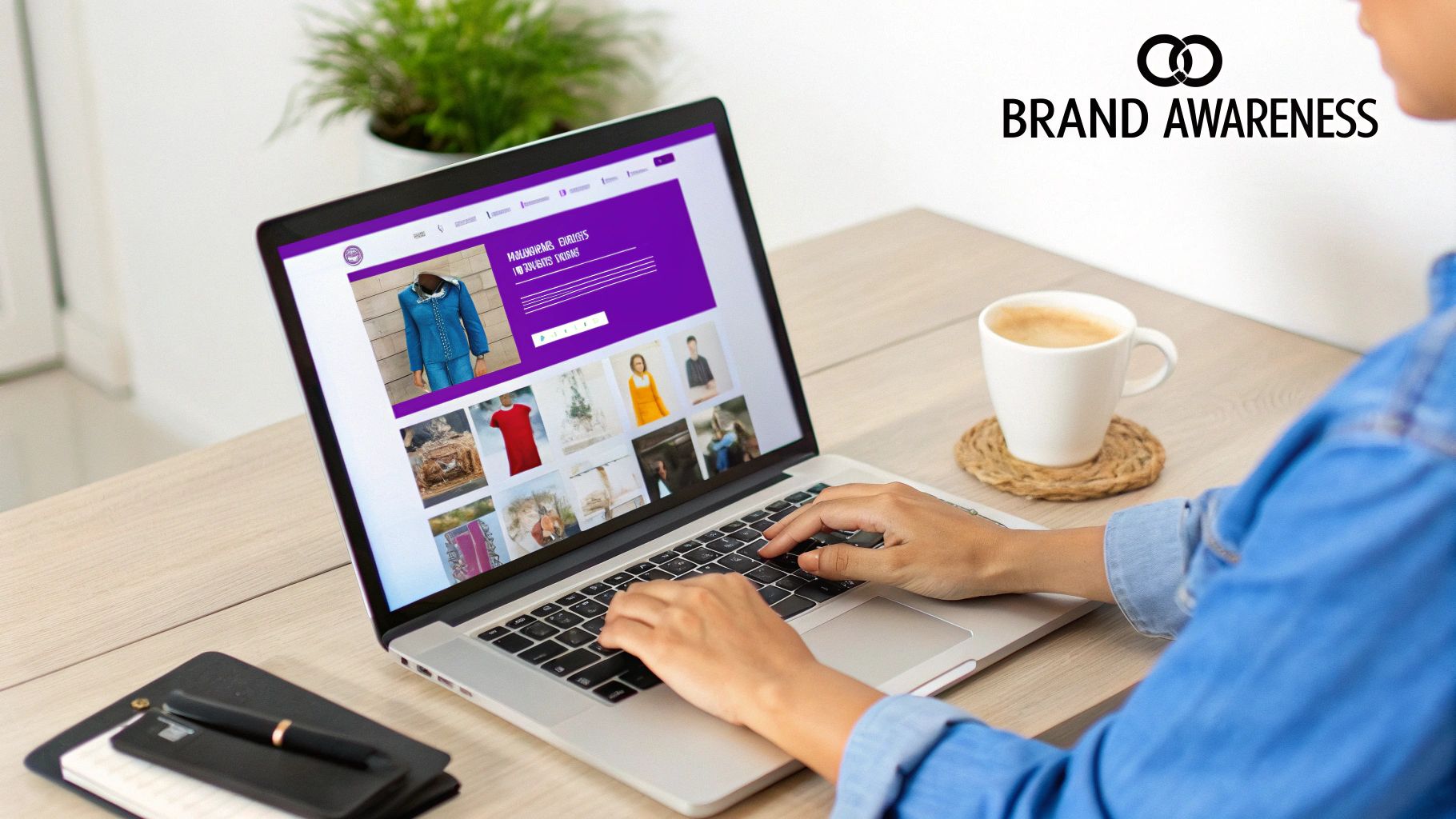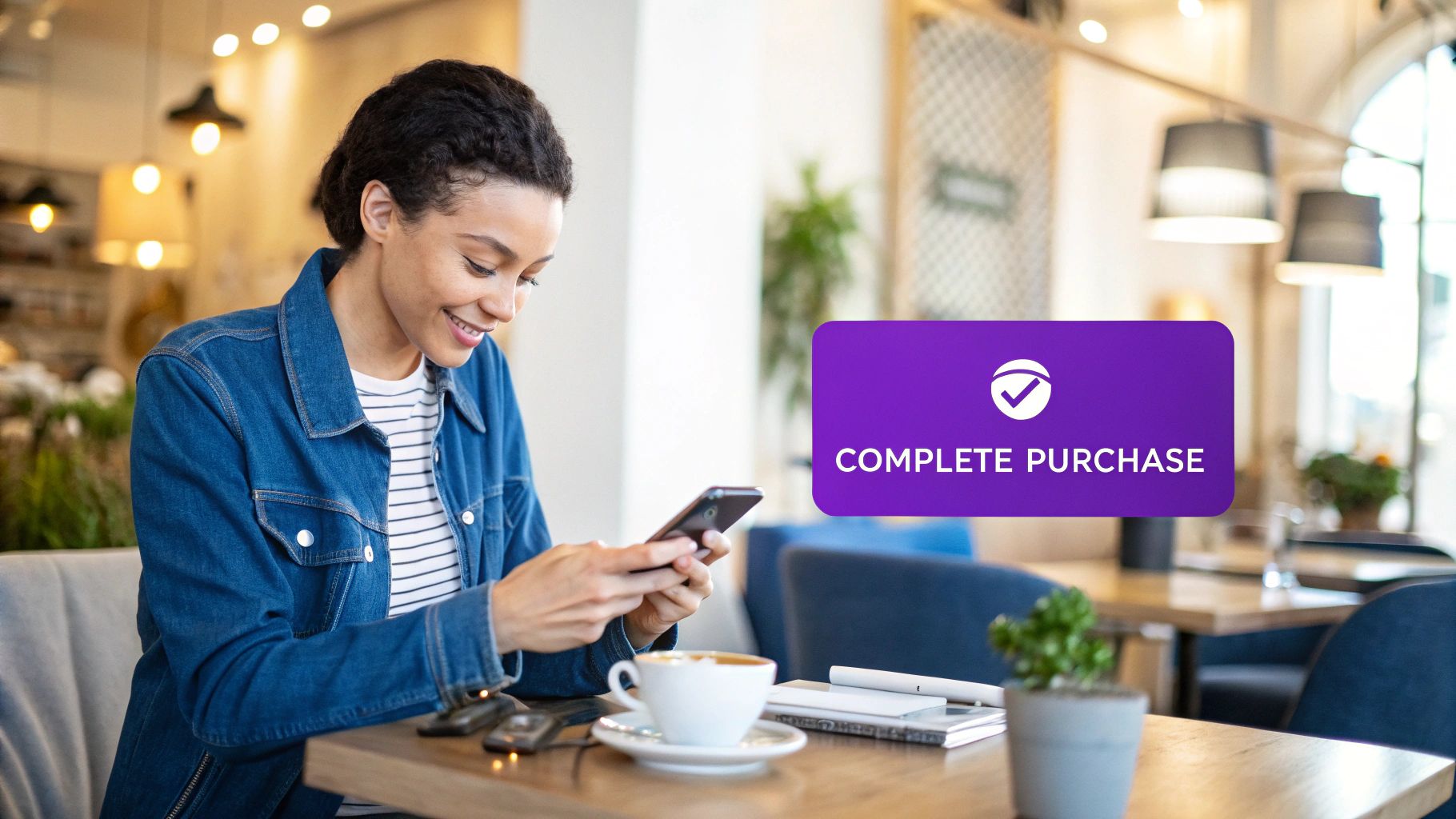Master Your Ecommerce Sales Funnel for Better Conversions

Mapping Your Ecommerce Sales Funnel For Maximum Impact

Most ecommerce businesses utilize a sales funnel, but surprisingly few truly understand how to maximize its potential. Visualizing your customer's journey is key. By recognizing how the ecommerce sales funnel differs from traditional marketing funnels, you can unlock significant growth. This section provides practical frameworks for mapping your own ecommerce sales funnel and finding high-impact optimization opportunities.
Understanding The Modern Ecommerce Funnel
The traditional AIDA model (Awareness, Interest, Desire, Action) offers a basic understanding, but the digital shopping world adds new layers. For instance, the "Interest" phase in ecommerce might involve in-depth product research on multiple platforms like Google Shopping. "Desire" could be swayed by social proof and user-generated content on platforms like Instagram. Your ecommerce sales funnel needs to account for these digital touchpoints.
The speed and ease of online shopping also requires a different approach. Customers can go from awareness to purchase in minutes, particularly for less expensive items. For higher-priced products, the ecommerce sales funnel might extend over days or even weeks, requiring ongoing engagement.
Visualizing Your Ecommerce Sales Funnel
Top ecommerce brands visualize their customer journey through different stages, tracking key metrics at each step. This helps pinpoint drop-off points and highlight areas for improvement. The data chart below shows a typical ecommerce sales funnel breakdown.
This bar chart illustrates the progressive narrowing of the funnel. The largest drop occurs between Awareness and Interest/Consideration, emphasizing the need to grab attention and drive traffic to product pages. Another notable drop is between Add to Cart and Checkout Started, suggesting friction in the checkout process. Analyzing this data helps pinpoint areas where optimization will have the greatest impact.
The importance of an effective sales funnel is clear. Nearly 570,000 websites use sales funnel technology. Businesses with effective funnels see an average of 102% higher deal size and 18 times greater revenue growth. However, only 17% of marketers have a fully functional sales funnel, revealing a significant opportunity. Find more statistics here: https://ecommercebonsai.com/sales-funnel-statistics/
Mapping Your Current Funnel
First, define the stages of your ecommerce sales funnel. These might include:
- Website Visit: The initial visit to your online store.
- Product View: When a customer views a product page.
- Add to Cart: Adding a product to their cart.
- Checkout Initiated: Starting the checkout process.
- Purchase Completed: Finalizing the purchase.
Track metrics for each stage, like visitor count, conversion rates, and average order value. This data provides a baseline and allows for strategic optimization.
To further illustrate the differences between traditional and modern ecommerce approaches, let's look at a comparison table:
Ecommerce Sales Funnel Stages Comparison: Comparing traditional marketing funnel stages with modern ecommerce funnel stages and their key objectives.
This table highlights the shift towards a more customer-centric and data-driven approach in modern ecommerce. By focusing on the key metrics at each stage, businesses can optimize their funnel for maximum impact and drive sustainable growth.
Top-of-Funnel: Attracting Visitors Who Actually Buy

Getting folks to visit your ecommerce store is a great start, but it's only half the battle. Simply driving traffic isn't enough; you need the right kind of traffic. This section explores how successful ecommerce brands attract those highly motivated visitors, concentrating on building a solid ecommerce sales funnel.
Defining Your Ideal Customer Profile
Before we get into specific strategies, let's talk about who you're trying to reach. Defining your ideal customer profile (ICP) is about more than just demographics. You need to understand your customer's needs, what motivates them, and how they behave online. Analyze your existing customer base, looking for trends in their purchase history and how they interact with your brand. Market research and checking out what your competitors are doing can also provide valuable clues. For example, if you sell handmade jewelry, your ICP might be a millennial with disposable income who appreciates unique, handcrafted items and is active in online artisan communities.
SEO Strategies for Product-Based Businesses
SEO is essential for attracting qualified visitors. However, product-based businesses need a slightly different approach. Your keyword research should concentrate on product-specific terms, long-tail keywords related to product features and benefits, and even competitor product names. Instead of simply targeting "shoes," try "handmade leather sandals for women" or "vegan running shoes with arch support." This focused approach brings in visitors actively searching for exactly what you offer.
Content That Converts
Content marketing is key for attracting and engaging potential customers. Create content that not only performs well in search results but also speaks directly to your ICP's needs and interests. Think blog posts comparing different product types, how-to videos showcasing product use, or buying guides to help customers make the right choice. Quality content builds trust and establishes your brand as an expert in your niche, making you the go-to resource and boosting your chances of turning visitors into buyers.
Data-Driven Advertising
Paid advertising can be very effective for attracting visitors at the top of your ecommerce sales funnel. But, a data-driven approach is a must. Define clear campaign goals, target specific demographics and interests, and constantly analyze performance data to refine your campaigns. For example, Facebook Ads lets you target users who've shown interest in similar products or engaged with related brands. This targeted approach maximizes your return on investment by zeroing in on those with high potential.
Measuring Top-Funnel Success
Website traffic is important, but it's not the whole story. Pay attention to metrics that reveal genuine engagement and buying intent:
- Click-Through Rate (CTR): How often people click on your ads or search results.
- Bounce Rate: The percentage of visitors who leave after viewing only one page. A high bounce rate could mean your content isn't connecting with your audience.
- Time on Site: How long visitors spend on your site. Longer visits usually mean higher engagement.
- Pages Per Session: The average number of pages viewed per visitor, showing how thoroughly they're exploring your site.
By tracking these metrics, you can evaluate the effectiveness of your top-of-funnel activities and make informed adjustments. This constant optimization ensures you're not just attracting visitors, but visitors who are genuinely interested in what you offer and likely to become customers. This is the foundation of a successful ecommerce sales funnel. Wand Websites helps Etsy businesses transition to independent Shopify websites and build effective funnels by creating high-performing, conversion-focused websites.
Middle-of-Funnel: Turning Browsers Into Potential Buyers

The middle of your ecommerce sales funnel is where the magic happens. It's where interested visitors weigh their options, and where you can truly shine. This is all about the consideration phase. Let's explore how successful brands build trust and demonstrate value during this crucial stage, turning casual browsers into serious potential buyers.
Optimizing Product Pages For Conversions
Your product pages are the heart of your ecommerce sales funnel. They're where the action happens. To attract visitors ready to buy, think about strategies to increase ecommerce sales. Instead of guessing, look at the data. Analyze how shoppers interact with your product pages. Where do they linger? What questions are they asking (either directly or through their behavior)?
Use this valuable data to craft compelling product descriptions that answer those questions, highlight the key benefits, and address any potential objections. Don't forget the visuals! High-quality images, videos, and even interactive 360-degree views can elevate the shopping experience and encourage those all-important conversions.
Building Trust Through Transparency
Trust is the foundation of any successful sale. Be upfront with your customers. Displaying clear information about shipping costs, return policies, and security measures can go a long way in easing customer concerns. Authentic customer reviews and testimonials can also be incredibly persuasive.
Don't underestimate the power of social proof. Showcasing user-generated content or influencer endorsements further strengthens your credibility and builds confidence, encouraging potential buyers to move to the next stage of the ecommerce sales funnel.
Leveraging Educational Content
The middle of the funnel isn't just about the hard sell; it's also a prime opportunity to educate. Creating valuable content that addresses customer needs and empowers them to make informed decisions can position your brand as a trusted advisor.
Think blog posts comparing different product options, buying guides explaining key features, or videos demonstrating how to use your products. This kind of content builds trust, reduces buying anxiety, and gently nudges prospects further down the ecommerce sales funnel.
Personalization Beyond Tracking
Personalization shouldn't feel creepy. In the middle of the funnel, it's about providing a helpful, tailored experience. Ecommerce sales funnels, in particular, benefit from personalized content. Personalized calls to action (CTAs), for example, can see performance improvements of up to 202% compared to standard CTAs. Adding video content can boost conversion rates by 66%. Want more insights? Check out these stats on ecommerce personalization and conversion rates.
Instead of simply tracking behavior, use the data to offer tailored product recommendations, display relevant content, and create personalized shopping experiences that resonate with individual needs and preferences. Show your customers you understand them, and watch engagement and conversions soar.
Rethinking Retargeting Campaigns
Many retargeting campaigns fall flat because they're too generic and repetitive. Nobody wants to see the same ad endlessly. Instead, segment your audience based on their behavior and show them tailored ads that speak to their specific interests.
For example, if someone abandons their cart, show them an ad featuring the items they left behind, perhaps with a little incentive like free shipping. This targeted approach is much more effective than generic retargeting.
Nurturing Leads With Email
Email nurturing is key for keeping prospects engaged and guiding them towards a purchase. But resist the urge to rely solely on discounts. Instead, provide valuable content, offer personalized product recommendations, and remind them of the benefits of your products. This cultivates a relationship with potential buyers, keeping your brand top-of-mind without resorting to constant discounts. These strategies are particularly important for businesses like Etsy sellers transitioning to Shopify, where building a direct customer relationship is essential for long-term success. Wand Websites helps Etsy businesses build effective ecommerce sales funnels and create high-performing Shopify websites to scale their brand and boost conversions.
Bottom-of-Funnel: Converting Without Killing Profits
The bottom of your ecommerce sales funnel is where the magic happens. It's where browsers transform into buyers. But it's not just about securing the sale; it's about maximizing your profits while ensuring a smooth and enjoyable customer experience. Let's explore how successful ecommerce brands optimize this critical stage.
Streamlining The Checkout Process
A complicated checkout process is a guaranteed way to lose customers. We've all been there, abandoning an online cart because the checkout was simply too much hassle. Unfortunately, this is a common occurrence for many online shoppers. Smart ecommerce brands recognize this and prioritize a frictionless checkout experience. This involves minimizing the steps required, providing guest checkout options, and clearly displaying shipping costs and estimated delivery times upfront.
Pricing Psychology and Promotions
Pricing is more than just numbers; it's a psychological game. Smart pricing tactics, such as charm pricing (using .99 endings) or offering bundled deals, can greatly influence purchase decisions. Strategic promotions can further incentivize buying without sacrificing your profit margins. For instance, offering free shipping on orders over a certain threshold can encourage larger purchases and boost your average order value.
Upselling and Cross-Selling That Works
Upselling and cross-selling, when implemented effectively, can increase sales and improve the customer experience. The key is relevance. Suggest products that complement existing items in the cart or truly enhance the customer’s purchase. Imagine a customer buying a camera; recommending a compatible lens or memory card is a natural fit. Avoid pushing unrelated products, as this can feel intrusive and erode customer trust.
Crafting Compelling Calls to Action
Your calls to action (CTAs) should be clear, concise, and motivate action. Use action-oriented language, such as "Shop Now" or "Get Your Free Quote," and make them visually prominent. Experiment with different CTAs to identify what resonates best with your target audience. A/B testing can be invaluable in determining the most effective wording and placement.
Using Urgency and Scarcity Ethically
Urgency and scarcity can be potent motivators, but they must be used responsibly. Be transparent and honest about any limited-time offers or limited quantities. Never create artificial scarcity or resort to manipulative tactics, as this can damage your brand's reputation.
Systematic Testing and Optimization
The bottom of the funnel demands continuous testing and optimization. Monitor essential metrics, like cart abandonment rates and conversion rates, to pinpoint areas for improvement. Test different checkout processes, pricing strategies, and promotional offers to uncover what delivers the best results. This data-driven approach ensures you’re continually refining your strategies for maximum profitability. This is especially vital for businesses moving from platforms like Etsy to independent Shopify stores, where a fully optimized ecommerce sales funnel is crucial for success. Wand Websites specializes in helping Etsy businesses build effective ecommerce sales funnels by creating high-performing, conversion-focused Shopify websites.
Let's take a look at some key statistics:
To illustrate the impact of optimization techniques on your checkout process, let's examine the following table:
Ecommerce Checkout Optimization Statistics
These statistics highlight the potential gains from various optimization techniques. While some are easier to implement than others, all can contribute to a significant improvement in your conversion rate.
The global ecommerce market, predicted to reach $4.8 trillion in 2025, emphasizes the importance of sales funnel optimization. Key metrics like bounce rates, add-to-cart rates, and purchase rates are vital for identifying areas for improvement. Even using advanced tools like AI-powered product recommendations and automated abandoned cart emails can significantly boost conversions. Learn more about global ecommerce trends: https://www.shopify.com/enterprise/blog/global-ecommerce-statistics
Optimizing for Mobile
With the rise of mobile shopping, a seamless mobile checkout experience is essential. A mobile-friendly checkout, optimized for smaller screens and touch navigation, can dramatically improve conversion rates. This includes simplifying form fields, providing mobile payment options, and ensuring quick loading times.
Post-Purchase: Transforming One-Time Buyers Into Advocates

Many businesses concentrate on acquiring new customers, but sometimes forget the potential of their existing customer base. The post-purchase phase of the ecommerce sales funnel is where you turn one-time buyers into loyal advocates and repeat customers. This leads to increased customer lifetime value (CLTV) and sustainable business growth.
Crafting Effective Follow-Up Sequences
Following up after a purchase is important, but you don't want to overwhelm your customers. The goal is to build a relationship. Successful brands use automated email sequences that provide more than just order confirmations.
For instance, you might send personalized product recommendations, helpful tips about their purchase, or exclusive content. This keeps your brand in their minds and encourages them to come back.
Building a Loyalty Program That Drives Repeat Purchases
Loyalty programs can be very effective. However, many just focus on accumulating points. Instead, design your program to give real benefits that customers appreciate.
Some ideas include exclusive discounts, early access to new products, free gifts, or personalized experiences. Rewarding loyalty and making customers feel valued should be the primary focus.
The Unboxing Experience: Creating an Emotional Connection
The unboxing experience is a great chance to create a memorable moment. A well-designed package, a handwritten thank you note, or a small gift can build a strong emotional connection with your brand. This personal touch makes a positive impression that algorithms can't replicate.
Gathering Actionable Feedback for Continuous Improvement
Customer feedback is essential for improving your products and your ecommerce sales funnel. Use easy ways to get feedback, like post-purchase surveys or emails.
Make it simple for customers to share their thoughts, and always respond to their feedback. This shows you value their opinions and want to provide the best experience possible.
Identifying Complementary Offerings That Customers Appreciate
Offering related products or services is a good way to increase sales and customer satisfaction. But, these offerings must be relevant and valuable to the customer.
Analyze purchase data and customer feedback to find products frequently bought together or that address a related need. This targeted approach makes your upsells and cross-sells feel helpful, not pushy.
For established businesses, a strong post-purchase customer relationship is key for long-term growth. This involves strategies for recovering abandoned carts and nurturing leads. One critical aspect of the bottom-of-funnel stage is effectively addressing cart abandonment. For helpful strategies on recovering abandoned carts, check out this article. This is especially important for Etsy sellers expanding to platforms like Shopify, where a well-designed post-purchase experience within the ecommerce sales funnel can significantly impact revenue. Wand Websites assists Etsy businesses in building effective ecommerce sales funnels and creating high-performing Shopify websites to improve post-purchase engagement and drive repeat business.
Measuring What Matters in Your Ecommerce Sales Funnel
After mapping your ecommerce sales funnel and optimizing each stage, measuring its effectiveness becomes crucial. Many ecommerce businesses find themselves swimming in data but struggling to extract meaningful insights. This section explores how successful brands pinpoint the key performance indicators (KPIs) that truly predict success and fuel continuous improvement.
Setting Up Proper Tracking
Before diving into specific metrics, having the right tracking mechanisms in place is essential. Setting up proper tracking across your entire ecommerce sales funnel, from the first website visit to post-purchase engagement, doesn’t require a team of data scientists. Tools like Google Analytics and enhanced ecommerce tracking offer comprehensive data on user behavior, conversion rates, and revenue.
Integrating your ecommerce platform with your CRM system provides a unified view of customer data, offering valuable insights into individual customer journeys and lifetime value. This integrated approach creates a seamless flow of information, empowering data-driven decisions at every stage of the ecommerce sales funnel.
Building Meaningful Dashboards
Raw data can be overwhelming. Successful ecommerce brands build dashboards that visualize key metrics clearly and actionably. Instead of just displaying numbers, these dashboards highlight trends, patterns, and anomalies. For example, a dashboard could visually represent the conversion rate at each stage of your ecommerce sales funnel, helping you quickly identify bottlenecks and areas for improvement.
Identifying Industry Benchmarks
To understand how your ecommerce sales funnel performs, compare your performance against industry benchmarks. Resources like industry reports and competitor analysis provide valuable context for your metrics. For example, if your average cart abandonment rate is significantly higher than the industry average, it indicates a need to optimize your checkout process. Understanding these benchmarks helps you set realistic optimization goals and prioritize improvements.
Setting Realistic Optimization Goals
Data without context lacks meaning. Successful brands establish SMART goals – Specific, Measurable, Achievable, Relevant, and Time-bound – based on their current performance and industry benchmarks. Instead of aiming for a general increase in conversions, define a specific target, such as increasing the conversion rate from "Add to Cart" to "Purchase Completed" by 5% within the next quarter.
Prioritizing Improvements Based on Impact
Not all optimizations are equally effective. Prioritize improvements based on their potential impact on revenue, not on effort or guesswork. The ICE framework can help with this:
- Impact: How significantly will this optimization affect key metrics?
- Confidence: How certain are you that this optimization will succeed?
- Ease: How simple is it to implement this optimization?
By prioritizing high-impact, high-confidence optimizations, you focus on changes that will deliver the greatest results for your ecommerce sales funnel. For instance, if optimizing your checkout process has a greater projected impact on revenue than redesigning your homepage, prioritize the checkout process. This strategic approach ensures efficient resource allocation and maximizes ROI.
Ready to transform your Etsy shop into a thriving independent ecommerce business? Wand Websites specializes in building high-performing Shopify websites optimized for conversions. We handle everything from design and development to SEO and marketing, allowing you to focus on what you do best: crafting amazing products. Visit Wand Websites today to learn more and schedule a free consultation.


